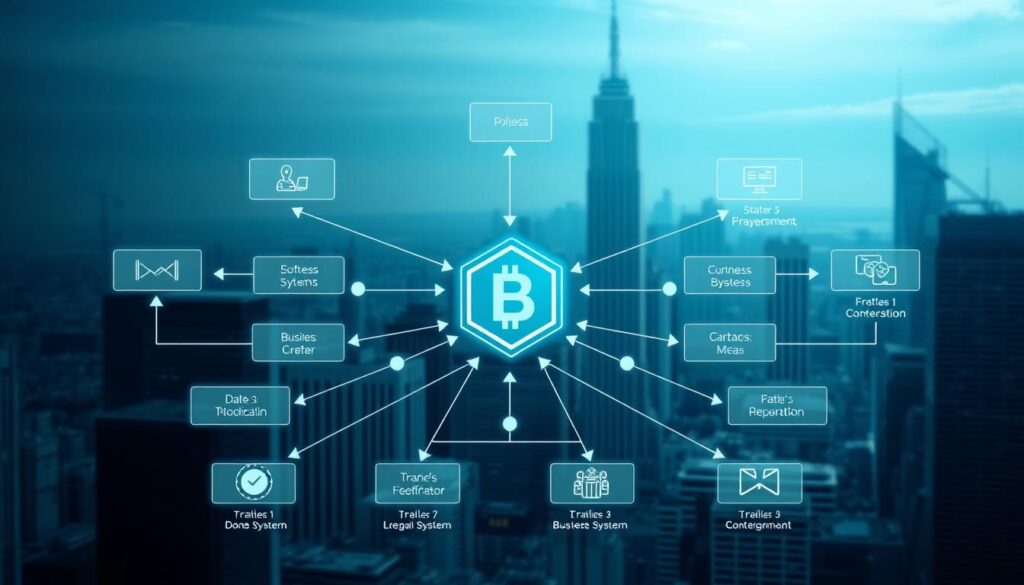Now Reading: Blockchain Integration Legacy System Connection Solutions
- 01
Blockchain Integration Legacy System Connection Solutions
Blockchain Integration Legacy System Connection Solutions

Many companies today face a difficult situation. Their core operations run on older computer frameworks. These frameworks hold years of important data and processes. But they often struggle to work with newer, more powerful tools.
A recent survey shows a clear problem. About 80% of businesses say their old tech slows down progress. This creates a major need for smart modernization solutions.
New digital ledger technology offers a powerful way forward. It brings better security, clear visibility, and smoother operations. Linking this new tech with existing setups is a key challenge for leaders.
The payoff for getting it right is huge. Companies can see operational costs drop significantly. This is true in fields like finance, healthcare, and logistics. It’s not just an upgrade; it’s a transformation in how business is done.
This process requires careful planning. It is a strategic project, not a simple fix. The goal is to blend the best of the old with the power of the new.
Key Takeaways
- Older operational frameworks are a major barrier to innovation for most companies.
- New digital ledger technology provides enhanced security, transparency, and efficiency.
- Connecting new and old tech is a complex but highly rewarding strategic initiative.
- Successful modernization can lead to substantial cost reductions across various industries.
- This transformation changes how businesses manage data and build trust.
- A phased, well-planned approach is essential for success.
Introduction to Blockchain Integration Legacy System Connection
Operational frameworks from a bygone era remain the backbone of many industries, yet they creak under modern demands. This creates a pressing need to understand the specific hurdles these setups create and the innovative approaches available to overcome them.
Overview of Legacy System Challenges
Outdated technologies often lead to significant operational bottlenecks. High maintenance costs can consume large parts of an IT budget. These funds could otherwise drive innovation.
These older setups also create integration difficulties. They prevent smooth data sharing between different parts of a company. This lack of connection forms information silos.
Security is another major concern. Aging platforms frequently have vulnerabilities. They are more exposed to modern cyber threats, posing a serious risk.
Blockchain as a Modern Solution
Digital ledger technology presents a powerful answer to these long-standing issues. Its core features directly tackle the weaknesses of older setups.
Decentralization is a key advantage. It removes single points of failure common in centralized architectures. This builds a more resilient operational foundation.
Transparency and immutability are equally important. They create an unchangeable record of transactions and data flows. This enhances trust and makes audits simpler.
| Aspect | Outdated Technologies | Modern Digital Ledger |
|---|---|---|
| Data Security | Centralized, vulnerable to single points of failure | Decentralized, cryptographic protection |
| Operational Transparency | Opaque processes, difficult to audit | Clear, immutable record of all actions |
| Maintenance Cost | Typically high and increasing over time | Potentially lower with distributed upkeep |
| Adaptability | Rigid, hard to update or scale | Designed for flexibility and future growth |
Understanding Legacy Systems and Their Limitations
Outdated computing environments that were once cutting-edge now represent significant barriers to business agility and innovation. These technological foundations, while historically valuable, create complex operational hurdles that demand careful analysis.
Defining Legacy Systems
These platforms are characterized by more than just age. They typically involve obsolete hardware infrastructure and deprecated software applications. This creates a complex web of outdated programming languages and proprietary data formats.
The paradox lies in their continued operation. They remain mission-critical, containing irreplaceable business logic and historical data. Yet this very importance makes replacement or modification exceptionally risky.
Common Challenges with Outdated Technologies
Maintenance expenses escalate dramatically over time. Skilled personnel familiar with older programming languages become scarce. Sourcing compatible replacement components for aging hardware grows increasingly difficult.
Security vulnerabilities represent another major concern. These platforms lack modern protection features and contain unpatched exploits. Their architectures were designed before current cyber threats existed, creating significant exposure.
Operational limitations further complicate matters. Limited interoperability forces manual data transfers and creates information silos. This prevents organizations from achieving the integrated, real-time visibility needed for competitive advantage.
The Need for Legacy System Modernization
The strategic imperative for technological evolution has never been more urgent for businesses relying on dated infrastructures. Maintaining outdated platforms creates significant competitive disadvantages that can impact long-term viability.
Modernization represents more than just technical upgrades. It’s about transforming how organizations operate and compete in digital markets.
Benefits of Upgrading Legacy Systems
Upgrading brings substantial operational improvements. Automation reduces manual errors and speeds up processes. This leads to better resource allocation.
Security enhancements protect sensitive data with contemporary protocols. Advanced analytics capabilities unlock valuable insights from existing information. Users benefit from intuitive interfaces that boost productivity.
Scalability ensures platforms can grow with organizational needs. Regulatory compliance becomes easier with modern frameworks. These advantages create a stronger competitive position.
Cost and Efficiency Implications
While modernization requires investment, the long-term financial benefits are compelling. Reduced maintenance expenses free up budget for innovation initiatives.
The transition phase needs careful management to minimize disruptions. However, successful implementations typically show significant returns. Operational efficiency improvements often justify the initial costs.
Strategic planning helps organizations navigate this change effectively. Phased approaches reduce risk while demonstrating value early. This makes the business case for modernization clear and achievable.
Blockchain Technology: An Overview for Businesses
Modern enterprises are discovering the transformative potential of decentralized digital records. This innovative approach moves beyond traditional centralized databases to create more resilient operational frameworks.
The technology operates across a distributed network of computers. Each participant maintains a copy of the entire record. This creates a system where no single entity controls the data.
Decentralization and Transparency
Distributed ledger technology eliminates central points of control. Information spreads across multiple nodes in the network. This architecture prevents single points of failure.
All participants can view transaction histories while maintaining privacy. Cryptographic techniques protect sensitive details. This balance creates unprecedented audit capabilities.

Consensus mechanisms ensure agreement on the ledger’s state. Different algorithms like Proof of Work and Proof of Stake validate entries. This process maintains data integrity across the entire system.
Role of Smart Contracts in Automation
Self-executing contracts represent one of the most powerful business applications. These digital agreements automatically enforce terms when conditions meet.
Smart contracts reduce manual intervention in complex workflows. They can process payments upon delivery confirmation. They also handle insurance claims based on verified conditions.
These automated agreements serve as intelligent bridges between different platforms. They consistently enforce business rules across various operational environments. This creates auditable records of all interactions.
| Feature | Traditional Systems | Blockchain Approach |
|---|---|---|
| Data Control | Centralized authority | Distributed across network |
| Transaction Visibility | Limited to authorized parties | Transparent to participants |
| Process Automation | Manual or intermediary-dependent | Smart contract-driven |
| Data Integrity | Subject to centralized alteration | Immutable through consensus |
Key Features and Benefits of Blockchain
Digital ledger technology introduces fundamental advantages that transform how organizations handle critical information. These features address core business challenges with innovative solutions.
Enhanced Security and Data Integrity
Blockchain provides exceptional protection through cryptographic techniques. Once information enters the ledger, altering it requires network consensus.
This creates permanent, tamper-proof records. Digital signatures verify transaction authenticity while encryption safeguards sensitive data.
The distributed nature eliminates single points of failure. Multiple layers of security protect against cyber threats more effectively than traditional methods.
Improved Transparency and Trust
All authorized participants access the same verified information. This shared visibility builds confidence among business partners.
Every action creates an auditable trail. Organizations can track movements and verify compliance in real-time.
This transparency reduces disputes and manual reconciliation. The technology establishes verifiable proof that enhances accountability across transactions.
Blockchain Integration Legacy System Connection in Action
The transition from theory to practice reveals powerful outcomes when innovative record-keeping technology augments traditional operations. Real-world applications demonstrate this synergy across multiple industries.

In supply chain management, companies achieve unprecedented visibility. They track products from origin to consumer with verified authenticity. This approach builds trust and reduces fraud.
Healthcare organizations securely share patient information across different providers. They maintain privacy while improving care coordination. This eliminates duplicate tests and medical errors.
Financial institutions are transforming their services. They enable faster settlements and reduce intermediary costs. These solutions create more efficient markets.
| Industry Sector | Primary Application | Key Benefit Achieved |
|---|---|---|
| Supply Chain | End-to-end product tracking | Enhanced transparency and fraud prevention |
| Healthcare | Secure patient data sharing | Improved care coordination and error reduction |
| Financial Services | Automated settlement processes | Faster transactions and lower costs |
| Luxury Goods | Origin verification and authentication | Brand protection and consumer confidence |
These practical implementations show how organizations enhance existing frameworks. They add new capabilities without replacing proven infrastructure. The results justify the strategic investment.
Step-by-Step Guide to Integrating Blockchain with Legacy Systems
Organizations seeking to enhance their technological capabilities must follow a systematic implementation process. This approach transforms a complex undertaking into manageable phases with clear milestones.
Initial Assessment and Strategy Development
The first phase involves comprehensive evaluation of current operations. Teams document workflows and identify technical dependencies.
This assessment helps pinpoint where digital ledger technology delivers maximum value. It establishes clear objectives for the modernization effort.
Key activities during this stage include:
- Analyzing data quality and consistency requirements
- Defining measurable success metrics
- Developing realistic timelines and resource plans
- Selecting appropriate platforms based on specific needs
Pilot Testing and Full-Scale Deployment
Starting with a limited-scope pilot project reduces risk while demonstrating value. Choose high-impact use cases that can show quick wins.
Successful pilots then expand to full implementation. This phased development allows for continuous improvement based on real-world feedback.
The deployment phase focuses on scaling proven solutions across the organization. It includes training programs and establishing monitoring procedures for long-term success.
Overcoming Integration Challenges
Organizational upgrades often stumble when confronting compatibility issues between old and new platforms. These obstacles require careful planning and strategic solutions to ensure successful technological transformation.
Addressing Technical and Security Hurdles
Technical barriers emerge when connecting modern platforms with older infrastructures. Different data formats and communication protocols create significant compatibility problems.
Custom APIs and middleware solutions help bridge these gaps effectively. They translate between different structures while maintaining data consistency across platforms.
Security concerns require special attention during technological transitions. Protecting sensitive information on transparent ledgers demands careful encryption strategies. Smart contract vulnerabilities need thorough testing before deployment.
Ensuring Regulatory Compliance
Meeting legal requirements presents another layer of complexity. Data sovereignty rules may restrict where information can be stored. Privacy regulations sometimes conflict with permanent record-keeping features.
Private permissioned networks offer practical solutions for sensitive data handling. They provide the benefits of distributed technology while maintaining necessary controls.
Working with legal experts ensures all compliance standards are met. Proper audit mechanisms satisfy regulatory requirements while leveraging new capabilities.
Emerging Tools and Technologies for Seamless Integration
A growing collection of specialized tools is making the modernization journey smoother for enterprises. These technologies are designed to bridge the gap between old and new operational frameworks. They reduce the complexity and cost of such ambitious projects.
This ecosystem includes various platforms and services that handle the technical heavy lifting. The right tools can significantly accelerate implementation timelines.
APIs and Middleware Solutions
Application Programming Interfaces (APIs) act as essential translators. They allow existing business applications to communicate with new digital ledger networks. This avoids the need for a complete system rewrite.
Middleware handles the complex data flow between different architectures. It manages protocol conversion and ensures information consistency. These solutions are critical for a stable hybrid environment.
Key functionalities provided by modern integration tools include:
- Protocol translation between traditional and new network methods.
- Data format conversion for seamless information exchange.
- Transaction management to maintain integrity across systems.
When selecting tools, consider compatibility with your current setup. Also evaluate the development community support and security features. The goal is to find a robust and scalable solution for long-term success.
Customizing Solutions for Unique Business Needs
Every organization operates with a distinct combination of processes, data flows, and goals. This reality makes a one-size-fits-all modernization approach ineffective. Successful outcomes depend on creating tailored solutions that align with specific operational needs and strategic objectives.

A thorough analysis of your company’s specific requirements is the essential first step. This evaluation determines if this technology is the most effective tool for the job. It also guides the choice between different network types, like private or public ledgers.
Tailored Migration Strategies
Moving from an old setup to a new one requires a carefully planned strategy. The best path depends on factors like process complexity and risk tolerance. Organizations can choose from several effective approaches.
A phased migration gradually transitions functions over time. A parallel run operates both old and new systems together during the change. A hybrid model permanently keeps some tasks on the original platform while others move.
Optimizing Data Integrity and Access
Maintaining accurate information is critical during and after the transition. A key decision involves choosing what data lives on the permanent ledger versus off it. This balances the benefits of an unchangeable record with practical costs and performance needs.
Controlling who sees what information is equally important. Implementing role-based permissions ensures appropriate access for different users. Creating simple interfaces hides technical complexity, making the new capabilities easy to use.
| Business Factor | Customization Consideration | Potential Solution |
|---|---|---|
| Industry Regulations | Need for compliance (e.g., HIPAA, financial reporting) | Permissioned network with enhanced privacy controls |
| Data Sensitivity | Balancing transparency with confidentiality | Hybrid on-chain/off-chain data storage strategy |
| User Base Size | Ensuring performance for many participants | Scalable consensus mechanism and efficient query tools |
| Process Complexity | Automating multi-step workflows | Custom smart contracts designed for specific use cases |
Custom development is not a one-time event. It is an ongoing process of refinement based on experience and changing business requirements. The goal is to build an evolving capability that grows with your organization.
Best Practices for a Successful Integration Process
Adopting a structured approach dramatically increases the chances of a smooth technological transition. Following established guidelines helps organizations avoid common pitfalls and achieve better outcomes.
Begin with clear governance structures before starting any work. Create cross-functional committees with representatives from different departments. Establish regular communication rhythms to keep everyone informed.
Start with limited-scope pilot projects to prove value and build capability. This approach reduces risk and generates early wins. It allows teams to identify challenges in controlled environments.
Smart contract development requires special attention. Follow secure coding standards and implement comprehensive testing. Conduct security audits by independent experts for high-value applications.
Testing best practices include:
- Creating environments that replicate production conditions
- Developing comprehensive test cases for normal and edge scenarios
- Implementing automated frameworks for continuous validation
- Conducting performance testing to ensure requirements are met
Invest in team training and capability building. Provide education tailored to different roles. Create hands-on learning opportunities through sandbox environments.
After deployment, implement comprehensive monitoring systems. Establish performance metrics aligned with business objectives. Create alerting mechanisms that notify teams of issues early.
Maintain realistic expectations and a long-term perspective. Treat the process as continuous improvement rather than a one-time event. This mindset leads to ongoing refinement and greater success.
Case Studies and Success Stories
Real-world success stories provide compelling proof that modern record-keeping systems can transform traditional business processes. These examples show tangible benefits across various industries.

Real-World Implementations
Walmart’s collaboration with IBM created the Food Trust initiative. This approach tracks products from farm to store shelves. It dramatically improved food safety response times.
In healthcare, patient record sharing between providers became more secure. This enhanced care coordination while protecting privacy. Financial institutions streamlined cross-border payments using smart contracts.
Manufacturing companies achieved better quality control. They created verifiable records of component sourcing and production. Customers received authenticated product provenance information.
Key Takeaways and Measurable Outcomes
Successful projects share common factors. Executive sponsorship and clear business objectives drive results. Phased approaches prove value incrementally.
Measurable outcomes include significant cost reductions. Some organizations achieved 60% savings. Security improvements were reported by 60% of adopters.
Operational efficiency gains came from process automation. Enhanced transparency built trust with partners. Most implementations show return on investment within 18-36 months.
Conclusion
As organizations chart their course in an increasingly digital marketplace, strategic technology adoption becomes paramount. The journey of modernizing established frameworks with innovative solutions offers transformative potential for competitive advantage.
Successful modernization requires a balanced perspective—neither dismissing new approaches nor embracing them uncritically. The most effective implementations focus on business transformation rather than mere technical upgrades, delivering measurable value through enhanced security and operational efficiency.
While challenges exist in any technological transition, proper planning and phased approaches make these obstacles surmountable. The ongoing evolution of digital tools continues to reduce implementation barriers while expanding practical applications.
Organizations should begin their journey by identifying high-value use cases and conducting pilot projects. Embracing this strategic imperative positions businesses to thrive in a decentralized, transparent future where technological agility drives sustained success.
FAQ
What are the primary business benefits of connecting a legacy system to a blockchain network?
Linking outdated technologies with a modern network significantly boosts security and trust. It automates processes through smart contracts, reduces operational costs, and provides an immutable, transparent record of all transactions. This upgrade enhances data integrity and overall business performance.
How difficult is the deployment process for such a project?
The transition requires careful planning. A skilled team begins with an initial assessment to understand specific requirements. They then develop a tailored strategy, often starting with a pilot program for testing before moving to full-scale implementation. This approach manages risks and ensures a smoother adoption.
What role do smart contracts play in this type of modernization?
Smart contracts are self-executing agreements with terms written directly into code. They automate business logic from the old platform, streamlining operations like payments or supply chain tracking. This reduces manual intervention, minimizes errors, and increases the speed of transactions.
Are there solutions to help bridge the gap between old and new technologies?
Yes, tools like specialized APIs and middleware act as a crucial bridge. These solutions facilitate communication between the different systems, allowing data to flow securely without a complete overhaul of existing infrastructure. This makes the connection more manageable and cost-effective.
How is regulatory compliance handled during this integration?
Ensuring compliance is a critical step. The project team must identify all relevant regulations early in the development phase. The inherent transparency and audit trail of the technology can actually simplify reporting. However, legal experts should be involved to verify that the new application meets all necessary standards.
What are the long-term maintenance needs after integration?
Post-deployment, the combined system requires ongoing monitoring, updates, and potential training for staff. Regular maintenance ensures continued security and performance. While there are associated costs, they are often lower than maintaining the standalone legacy platform due to improved efficiency and automation.













